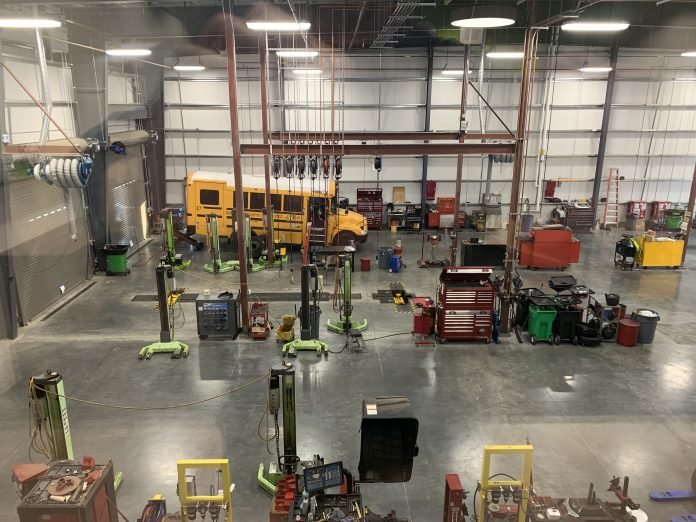Increasingly, stories emanate from across the school transportation industry about the construction of new state-of-the-art transportation facilities that promise much-needed space for new vehicles and technological equipment. Some of this is out of necessity— namely, replacing aging, cramped or crumbling buildings and infrastructure that long ago ceased being functional, reliable, or spacious enough for the many increasing needs of today’s fleets.
At its core, the latest technology in the shop means an improved ability of a district’s mechanics to service today’s school buses, boost uptime and slash on-the-road vehicle breakdowns. It is enabling shops to move away from preventive maintenance and toward predictive models.
This leads to more reliable vehicles on the road, which in turn creates an even safer environment for drivers and their student passengers, not to mention the greater motoring, pedaling and walking public. (And now there are “shared rideables,” i.e., electric bikes and scooters.)
This is the driving force behind the growing school bus “uptime” movement—the tagline for safety, reliable, efficiency and cost-savings in maintenance operations.
But student transporters are realizing that there are additional benefits from the many new school bus facilities that are springing up coast-to-coast. The growing list of resulting benefits are already beginning to pay for themselves through the positive daily effects they are having on transportation employees.
Department morale can be made or slayed in the driver’s and mechanic’s breakrooms, after all, as well as by the availability of the latest innovations that help them carry out their jobs better, faster and with more amenities. As profiled in Debbie Curtis’ garages profile that begins on page 34, a new $12 million transportation center renovation in Sacramento, California, not only features increased square footage in school bus service bays, new lighting and vehicle lift technology. It also boasts new employee fitness and wellness rooms.
The bottom line is that school districts nationwide are recognizing the importance of new facilities when competing to fill important staff vacancies. A shortage in mechanics is every bit as threatening as a lack of qualified and certified school bus drivers.
And like with drivers, the mechanic shortage is not just a student transportation problem. The shortage continues to extend to trucking companies that are under attack by shrinking delivery volumes and the booming oil industry, where news reports of many drivers earning six-figure salaries have become the norm now.
Of course, as STN’s recent surveys of driver and mechanic salaries confirm, and constant news reports remind everyone, most student transporters also remain woefully underpaid for the vital services they provide. Not surprisingly, the school bus industry largely has also remained a second, third or even fourth option for many job hunters.
Meanwhile, the ongoing revitalization of the U.S. economy and unemployment figures at a 50-year low haven’t helped the ability to fill driver and mechanic vacancies.
All of these, and more, lead to school district and bus company operations needing to do all they can to stand out from the crowd and attract the special kind of dedicated employee that this industry has relied on for over the past half-century. Solving the chronic vacancy problem requires new ways of doing things and locations to do them in. It requires prioritization, resolve, communications and help. It also requires money.
As this month’s garages feature demonstrates, many school districts are seizing on the revitalized economy and the loosening of taxpayer purse strings to pay for these new facilities. The school districts in New York, Texas and California we profile this month succeeded in convincing their constituents that new facilities are necessary tools to help deliver the transportation services that are expected of them.
But let’s face it, no amount of sparkling new transportation facilities, not to mention staff-appreciation lunches or subsidized health club memberships, will suddenly place the student transportation industry into the same conversation as Google and Netflix, when it comes to public discourse on perceived positive employee culture.
This is not to say that the values of those organizations are better. They might sound better to brag about at dinner parties, where status matters. But when honestly and realistically talking about working to change the world for the better, nothing rivals playing a daily, integral role in the education of our nation’s schoolchildren.
Investing in our industry and the children requires upgrades that bring operations into the 21st century. This is accomplished by investing in new vehicles, brick and mortar, and employees.
Editor’s Note: As reprinted from the February 2020 issue of School Transportation News.

















